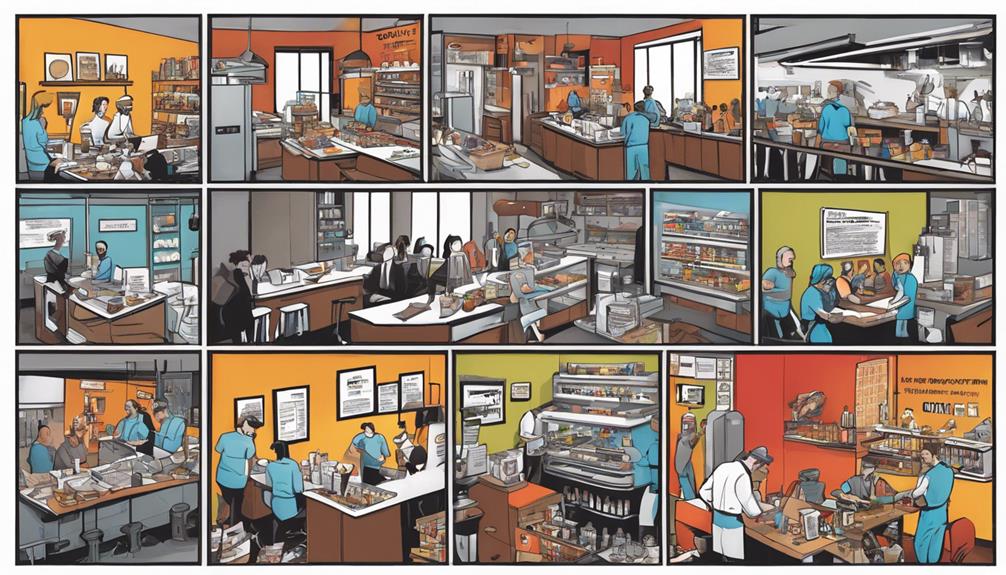RXBar's journey from a small kitchen startup in 2012 to a $600 million giant shows you the impact of authenticity and smart strategies. You'll see how founders Peter Rahal and Jared Smith focused on quality and transparency, creating a protein bar without additives. They faced production challenges but overcame them by building genuine relationships with fitness enthusiasts. Their minimalist branding resonated with health-conscious consumers, leading to their acquisition by Kellogg in 2017. This move not only solidified their market presence but also provided resources for further growth. There's much more to uncover about RXBar's success story ahead.
Key Takeaways
- RXBar was founded in 2012 by Peter Rahal and Jared Smith, focusing on high-quality, transparent ingredients in a home kitchen setting.
- The company faced production scaling challenges but overcame them by refining operations and securing reliable suppliers to meet growing demand.
- Strategic marketing efforts targeted CrossFit gyms, building a loyal customer base through genuine relationships and door-to-door sales tactics.
- In 2017, RXBar was acquired by Kellogg for $600 million, aligning with its values of transparency and integrity while enhancing market reach.
Founding Story of RXBar
In 2012, Peter Rahal and Jared Smith started RXBar in Rahal's parents' kitchen, driven by a philosophy that prioritized action over endless discussion. You can imagine the hustle as they experimented with recipes, focusing on high-quality ingredients and transparency.
They aimed to create a protein bar that reflected their values, avoiding unnecessary additives. Their mantra was simple: just sell a thousand bars. By adopting this hands-on approach, they quickly connected with their target audience.
Each bar was carefully crafted, showcasing minimal ingredients. This authenticity resonated with consumers, setting the stage for RXBar's eventual success. Their journey from a small kitchen to a brand with a mission started with determination and a commitment to doing, not just talking.
Early Growth and Challenges

After establishing a strong foundation, RXBar faced early growth challenges that tested your innovative spirit and commitment to quality.
You quickly realized that scaling production while maintaining the same high standards wouldn't be easy. The kitchen setup, while intimate, couldn't keep up with increasing demand. You needed to streamline operations and find reliable suppliers to guarantee ingredient integrity.
Additionally, you faced stiff competition in the nutrition bar market, compelling you to refine your branding and marketing strategies. With a focus on transparency and simplicity in packaging, you began to resonate with health-conscious consumers.
Each hurdle became a stepping stone, driving your determination to build a brand that stood out and thrived amidst the chaos of early growth.
Strategic Sales Approach

Focusing on targeted outreach, RXBar adopted a strategic sales approach that initially zeroed in on CrossFit gyms to build a loyal customer base. By connecting directly with fitness enthusiasts, they established a strong foothold in the health-conscious market. This hands-on method allowed RXBar to foster genuine relationships and gather valuable feedback.
RXBar utilized door-to-door sales tactics to reach local gyms. They provided personal contact information on packaging to enhance customer service. The company expanded its reach to cities like Milwaukee, Minneapolis, and Indianapolis.
This proactive strategy not only boosted sales but also created a community of loyal customers who felt personally connected to the brand. RXBar's commitment to service set it apart in a competitive nutrition bar market.
Branding and Market Positioning

RXBar's branding strategy centers on transparency and simplicity, which effectively distinguishes it in a crowded nutrition bar market.
You'll notice the minimalist packaging that boldly lists ingredients, emphasizing the ‘No B.S.' approach. This resonates with health-conscious consumers who value honesty in food products.
The iconic design not only captures attention but also communicates trustworthiness, enhancing your connection to the brand.
RXBar's targeted marketing efforts, including product sampling at events, provide insights directly from consumers, allowing for continuous improvement.
By understanding your needs and preferences, RXBar positions itself as a leader in the health snack category.
This focus on authenticity and customer engagement has driven significant growth and solidified RXBar's reputation among its competition.
Acquisition by Kellogg

The success of RXBar's branding strategy caught the attention of Kellogg, leading to a significant acquisition in 2017 for $600 million. This deal allowed RXBar to leverage Kellogg's extensive resources while maintaining its unique identity and mission.
You might find it interesting to know:
- The founders prioritized solving customer problems over selling the business.
- Positive interactions with large food companies influenced their decision to partner with Kellogg.
This strategic move not only solidified RXBar's position in the market but also opened up avenues for growth and development, paving the way for the brand's future successes.
Corporate Synergies and Growth

Kellogg often provides RXBar with valuable resources and expertise, enabling the brand to accelerate its growth and enhance product development.
By leveraging Kellogg's extensive distribution network, RXBar reaches new markets faster, getting its products into more hands.
You'll see RXBar benefiting from shared marketing strategies, boosting brand visibility and consumer engagement.
The collaboration fosters innovation, allowing RXBar to develop new flavors and products that align with consumer trends.
Additionally, access to Kellogg's research and development capabilities helps RXBar refine its recipes and packaging.
This synergy not only strengthens RXBar's position in the competitive snack industry but also cultivates a culture of continuous improvement, ensuring the brand stays relevant and appealing to health-conscious consumers.
Workplace Culture and Employee Engagement

A thriving workplace culture fosters genuine care for employee well-being, leading to higher satisfaction and retention rates.
At RXBar, this commitment is evident in various initiatives that prioritize employee engagement. You'll find that a positive environment not only boosts morale but enhances productivity.
- Open communication channels encourage feedback and ideas.
- Recognition programs celebrate individual and team achievements.
Conclusion
RXBar's journey illustrates how passion and innovation can transform a simple idea into a thriving brand. By focusing on creating a protein bar with minimal, whole food ingredients, the founders of RXBar brought a fresh perspective to the crowded market. Their passion for clean eating and commitment to using transparent, easy-to-understand ingredient lists resonated with consumers looking for a healthier snack option. Like a chef and diners enjoying a delicious meal, RXBar’s dedication to quality and innovation has resulted in a loyal customer base and continued success in the health food industry.
Just like the story of a local gym that started offering RXBars to its members, which sparked a surge in demand, you can see how targeted outreach and a strong brand identity can lead to explosive growth.
By focusing on quality and strategic marketing, RXBar not only captured hearts but also carved out a significant place in the nutrition bar market.








